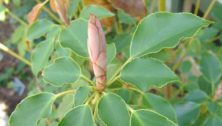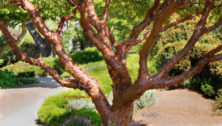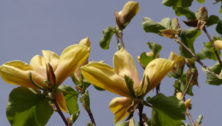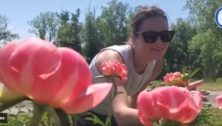In the Garden With Andrew: Planting Tropicals in the Garden
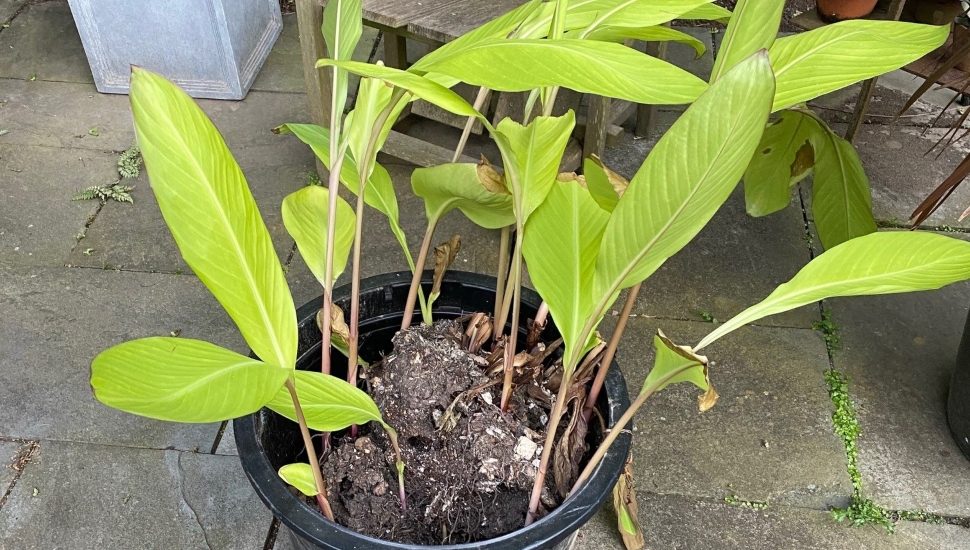
By Andrew Bunting
May is one of my favorite times on the gardening calendar. I like to give my garden a tropical touch by adding wonderful plants like bananas, cannas, and elephant ears. Over the last few weeks, I have been combing some of my favorite nurseries for some new tropicals.
Last weekend, I made a tour of several in Lancaster: Groff’s Plant Farm in Kirkwood, and Briar Rose Greenhouse, Black Creek Nursery, and Conestoga Nursery in East Earl. Yesterday, I hit Marano Gardens in Fort Washington and the Rhoads Garden in North Wales.
I plan to visit Mostardi Nursery in Newtown Square in the near future — and of course, there are many other nurseries that carry tropicals as well. For me and many of my gardening friends and colleagues, this pilgrimage happens every year, as we emerge from the long winter re-energized and ready to get back out into the garden.
Tropical plants provide luxuriant and bold foliage. The bananas (genera Musa and Ensete) have stems up to 12 feet tall and luxuriant, strap-like leaves. Some canna cultivars have leaves that are similar to the banana’s, except that their leaves form clumps that face skyward. Some cultivars, like those in the Canova series, grow to only between 2 and 4 feet tall, while Canna musifolia grows from a rhizome (a thick root-like stem that grows underground) to a 12-foot plant within the space of a single growing season.
The myriad varieties of Colocasia (elephant ear) have large, broad, elephant-ear-like leaves that can be either diminutive or enormous. For example, the ‘Thai Giant’ variety, which can grow to be between 8 and 10 feet tall, can have leaves as large as 5 feet long and 5 feet wide!
Augmenting my newly purchased tropicals will be all the plants I harvested last fall and overwintered in my cool, damp basement. These include several cultivars of cannas, Colocasia (elephant ears), and some large red Abyssinian bananas, Ensete ventricosum ‘Maurellii’.
I also have rhizomes of many cultivars of Canna. I overwinter both the cannas and elephant ears in large black plastic nursery pots, with just a little bit of mulch to cover the root mass. Then, in the fall, I dig them up, remove most of the soil, cut back the foliage, and store the plants in the basement.
With the bananas, the approach is similar, but a bit more complicated. First, I cut all the foliage back to the main trunk (pseudo-stem) — which in some cases can be as high as 8 feet tall. Then I dig out just a small root ball (as if I were digging up a small tree), put the entire plant in a very large nursery pot and cover the roots with mulch.
I put all the banana plants in the basement for the winter. A key to overwintering tropicals is to keep them as dormant as possible. If it is too warm, or there is too much light, they will start to grow prematurely. So keep them in cool, relatively dry, and (if possible) dark conditions. A cellar or unfinished basement is perfect.
Just today, I started bringing my tropicals out of the basement and up to the patio, where it’s easier to “process” them and get them ready for planting. Inevitably, some will have started to grow. When that happens, I simply cut back their elongated and blanched foliage. I also cut back any of the previous fall’s dead leaves.
For the cannas and bananas, I shake off most of the soil clinging to the tuber (Colocasia) or rhizome (Canna), and then it is just a matter of re-planting them in the garden. Both can be planted 6 to 10 inches deep. (It is good practice to label each pot in the fall, so that, when spring comes, you still know what’s what.) The bananas will usually require a bit more cleanup, because the leaves that form the pseudo-stem or trunk will have desiccated over the winter and the dried up parts will need to be removed.
I cut back many of these leaves all the way to the “trunk.” While, in the fall, it can be quite a chore to get some of these huge, hefty bananas into the basement, over the winter they lose a lot of water from their stems, so bringing them out of the basement in the spring is much lighter work. Once I get them outside, I simply plant the bananas as I would a small tree.
All these plants benefit from an application of a slow-release or organic high-nitrogen fertilizer to give them a boost in the spring. Then the fun begins. As soon as the weather and the soils warm, the tropicals will grow in leaps and bounds.
__________

This article first appeared in The Swarthmorean. Andrew Bunting is the Vice President of Public Horticulture for the Pennsylvania Horticultural Society (PHSOnline.org) which uses horticulture to advance the health and well-being of the Greater Philadelphia region. Andrew has decades of horticultural experience, ranging from his tenures at public gardens in the U. S. and abroad, as well as a published author, gardening expert, and sought-after presenter.
To learn more about PHS or to become a member and support greening initiatives in over 250 neighborhoods, visit PHSonline.org.
Connect With Your Community
Subscribe to stay informed!
"*" indicates required fields























![95000-1023_ACJ_BannerAd[1]](https://vista.today/wp-content/uploads/2023/03/95000-1023_ACJ_BannerAd1.jpg)





















